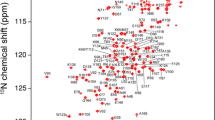Abstract
Stomatin, a 288-residue protein, is a component of the membrane skeleton of red blood cells (RBCs), which helps to physically support the membrane and maintains its function. In RBCs, stomatin binds to the glucose transporter GLUT-1 and may regulate its function. Stomatin has a stomatin/prohibitin/flotillin/HflK (SPFH) domain at the center of its polypeptide chain. There are 12 SPFH domain-containing proteins, most of which are localized at the cellular or subcellular membranes. Although the molecular function of the SPFH domain has not yet been established, the domain may be involved in protein oligomerization. The SPFH domain of the archaeal stomatin homolog has been shown to form unique oligomers. Here we report the 15N, 13C, and 1H chemical shift assignments of the SPFH domain of human stomatin [hSTOM(SPFH)]. These may help in determining the structure of hSTOM(SPFH) in solution as well as in clarifying its involvement in protein oligomerization.


Similar content being viewed by others
References
Cavanagh J, Fairbrother WJ, Palmer AGIII, Rance M, Skelton NJ (2006) Protein NMR spectroscopy, 2nd edn. Academic Press, San Diego, pp 533–678, 781–817
Delaglio F, Grzesiek S, Vuister GW, Zhu G, Pfeifer J, Bax A (1995) NMR Pipe: a multidimensional spectral processing system based on UNIX pipes. J Biomol NMR 6:277–293
Goda N, Tenno T, Takasu H, Hiroaki H, Shirakawa M (2004) The PRESAT-vector: asymmetric T-vector for high-throughput screening of soluble protein domains for structural proteomics. Protein Sci 13:652–658
Goddard TD, Kneller DG (2004) Sparky 3. University of California, San Francisco
Green JB, Fricke B, Chetty MC, von During M, Preston GF, Stewart GW (2004) Eukaryotic and prokaryotic stomatins: the proteolytic link. Blood Cells Mol Dis 32:411–422
Jung YS, Zweckstetter M (2004) Mars–robust automatic backbone assignment of proteins. J Biomol NMR 30:11–23
Kuwahara Y, Unzai S, Nagata T, Hiroaki Y, Yokoyama H, Matsui I, Ikegami T, Fujiyoshi Y, Hiroaki H (2009) Unusual thermal disassembly of the SPFH domain oligomer from Pyrococcus horikoshii. Biophys J 97:2034–2043
Langhorst MF, Reuter A, Stuermer CA (2005) Scaffolding microdomains and beyond: the function of reggie/flotillin proteins. Cell Mol Life Sci 62:2228–2240
Price MP, Thompson RJ, Eshcol JO, Wemmie JA, Benson CJ (2004) Stomatin modulates gating of acid-sensing ion channels. J Biol Chem 279:53886–53891
Zhang JZ, Hayashi H, Ebina Y, Prohaska R, Ismail-Beigi F (1999) Association of stomatin (band 7.2b) with Glut1 glucose transporter. Arch Biochem Biophys 372:173–178
Acknowledgments
This work was supported by Takeda Science Foundation and Suzuken Memorial Foundation. The authors are grateful to Mr. R. Taniguchi for his help in preparing the figure.
Author information
Authors and Affiliations
Corresponding author
Rights and permissions
About this article
Cite this article
Tsuruta, T., Goda, N., Umetsu, Y. et al. 1H, 13C, and 15N resonance assignment of the SPFH domain of human stomatin. Biomol NMR Assign 6, 23–25 (2012). https://doi.org/10.1007/s12104-011-9317-2
Received:
Accepted:
Published:
Issue Date:
DOI: https://doi.org/10.1007/s12104-011-9317-2




